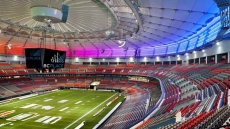Vancouver is one of four locations being considered as the North American West Coast destination for a history-making flight.
Scientists and pilots linked to the round-the-world flight of a solar-powered airplane are expected to decide the destination in the next month as they await a favourable weather window.
West Coast destinations, including Phoenix, the San Francisco area and Los Angeles, have been selected to allow maximum flexibility for route planning and weather conditions.
The Solar Impulse 2 is able to fly day and night without fuel and has completed one jump across the Pacific Ocean from Japan to Hawaii on its way across North America and Europe to Abu Dhabi.
But a news release from the programs co-founders says the 117-hour, 52-minute non-stop 8,900-kilometre flight last July overheated the batteries and the plane has been grounded in Hawaii since then, completing repairs and test flights.
The single-seat, carbon fibre Solar Impulse 2 weighs little more than a small car and has more than 17,000 solar cells built into its nearly 72-metre wingspan, providing renewable energy for four electric engines.
"An airplane with perpetual flight endurance, without fuel, like the Solar Impulse, is not only a first in the history of aviation, but also in the history of energy," Bertrand Piccard, the project's chairman, said in the release.
"The primary purpose of this adventure is to demonstrate that modern clean technologies can achieve the impossible and encourage everyone to use these same energy efficient solutions on the ground in their daily lives for mobility, construction, lighting, heating, cooling and more."




